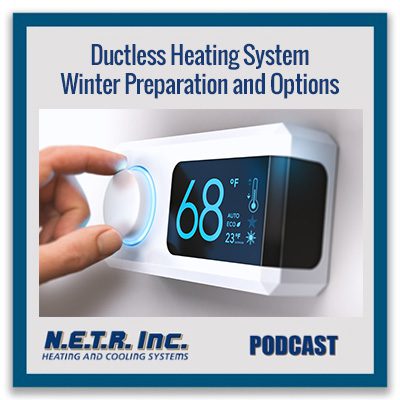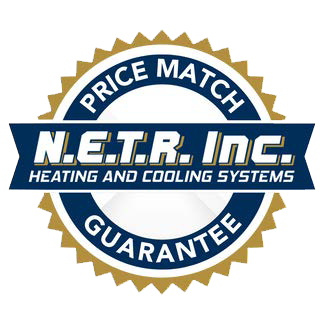
Mike Cappuccio, owner of N.E.T.R. Inc., a heating and cooling company based in Massachusetts, discusses winter ductless preparation and options.
John Maher: Hi, I am John Maher and I’m here today with Mike Cappuccio, owner of N.E.T.R. Inc., a heating and cooling company in Massachusetts. Today we’re talking about winter ductless prep and options. Welcome Mike.
Mike Cappuccio: Good afternoon, John. How are you?
Preparing Ductless Systems for Winter
John: Good, thanks. So Mike, we’re talking about ductless heating and cooling systems. And if I have a ductless system installed already, what should I be doing in order to prepare my system for the winter when it’s heating my house?
Mike: That’s a great question, John, because as you know, ductless is one of my favorite things that I do in this business, and it’s definitely a good topic because we see it all the time where people are not ready for winter, we get the first snow storm, and here we go, the ductless heating system is not heating their home and they, it just hasn’t been prepared properly. So the first thing I’m going to say is let’s make sure that the unit is on a stand and up off the ground by at least 12 inches.
The second thing I’m going to say is if you have trees and shrubs or plants that have grown around your ductless unit all spring and summer, that they are cut back. They’re away from the unit, that no snow and ice is going to be able to freeze on those and get into the fan section of the unit and just possibly something will fall and either go into the unit or possibly break a refrigerant line or an electrical line. Let’s make sure it’s all cleared away. All right? And the reason why too is God forbid, we get a big, big storm and you do need to get out there and clean off your heat pump or clear away some of the snow from it that you can get to it at that point in time.
We also want to make sure that the condenser coil is clean outside and then it can extract its heat. So that might need a coil cleaning before the winter time hits. And then on the inside unit, we want to make sure that the indoor unit is clean, that the fan is clean and clear of debris and dust and dirt, because that fan blade has a little scoop in it. It almost looks like a shovel and those scoops get filled up with dirt. And when those scoops are filled up with dirt, they don’t move as much air throughout the home and they can present a dirty, musty, moldy smell as well.
So we want to make sure that the indoor fan is clean. We want to make sure that the filters have been cleaned and that the anti-allergen filters have been replaced for the winter use if you are going to be using this unit to heat with. So we’ve got about six or seven checks there that need to get done. If none of that hasn’t been done, we can come into your home. We have the Hydro Clean machine that we can clean the indoor unit out, clean the fan blade out, clean that actual coil. And we can actually clean the outdoor unit with that, too, to make sure that that’s clean and we can cut back the trees and branches if need be to as well and get all that ready for the winter time.
Snow Drift Build-Up
John: You mentioned snow, obviously up here in New England. Some winters, we get a ton of snow. Sometimes in the back of my house, I know I get, when the wind blows, the snow comes right from my neighbor’s yard and blows right into the back of my house and I get these big drifts. Do I have to be really concerned about that if I’m getting snow drifts building up in that area where the ductless unit might be?
Mike: Yes, you do. John. If the unit is completely buried in snow, you’re going to have a problem. You’re going to need to either put some type of barrier in front of that unit or some type … I mean, I’ve actually had people build little lattice fences in front of a ductless system, so the snow can’t drift into it. I’ve had people build a little roof that can go over the top of them. I’m actually working on a plexiglass roof assembly right now that I’m actually designing that I can put on top of these units that we’re going to be able to sell the customers very soon.
Options for Ductless Heating Systems
John: Cool. So if I’m looking to have a ductless system installed, I don’t have one now, but I want to have one installed in order to help me to heat my house during the winter, what options should I be looking for in a ductless heating system?
Mike: Well, first off John, there’s a couple things are the heat pumps. So when we talk about heat pumps, we think heat. We think that everything heats, but they’re really, the most of your standard ductless heat pumps will only heat down to about 30 degrees, adequately. And then there’s the low ambient heat pumps. When we start looking, there’s a lot of different manufacturers now that make what we call low ambient heat pumps, or the lot of them now called cold weather heat pumps. What do I mean by that? Those heat pumps will actually give you the full BTU capacity at zero degrees. Some of them rate them at four degrees. Some of them rate them at five degrees. It depends on the manufacturer and what brand that you’re looking at. But you want to be looking at the cold weather heat pumps, especially here in New England, because those are the heat pumps that are going to give you the full heating capability at the low outdoor temperatures.
I mean, some of these heat pumps will give you 80 to 90% heating efficiency at -13 degrees. So for example, if you have a 24,000 BTU heat pump zero degrees, that heat pump would be giving you 24,000 BTUs of heating capacity in that home. A standard heat pump at say 20 degrees, 17 degrees, it might only give you 50% of that. So basically you’re taking a 24,000 BTU heat pump and it’s a 12,000 BTU heat pump. And I see that a lot because a lot of people buy a heat pump and then they find out on the first cold day, it really doesn’t heat. Well, it’s usually less expensive for that particular heat pump. It’s going to be less than a cold weather heat pump. And why is that? Because it doesn’t give you the heating capability that you need. So you’ve got to be very, very careful and look at the ratings on the BTUs at the cold temperatures.
John: And if I do get one of those cold weather ductless units, can I rely on that ductless system to heat my house for the whole winter, or does it kind of need to be used in conjunction with a traditional heating system that I might already have in my house?
Mike: You can use a ductless heating system to heat your house all winter, and you can use it in conjunction with your existing heating system. Now there’s a few things there that you’ve got to do. If you want to use this for a full heating system, we have to make sure that we put the proper capacity heat pumps in your home to heat when we do that. So we have to do a heat load calculation on your home. We’ve got to know a little bit about your windows, your insulation, things like that, to run a proper heat load on your home, and then provide you with the proper system at a low temperature. Now have I had people do this? Absolutely. Am I afraid to do it? No. A lot of people are like, “No, I would never use a ductless heat pump to heat my home.” I’m one of the ones who will disagree with you on that because I’ve done it and it works.
I’ve also done it in conjunction with a traditional heating system. Now I know Mass Save with oil heating now is offering some pretty substantial rebates. Some of them are about $1,250 per 12,000 BTUs of heating that you add in your home if you can integrate this with oil into your home. Now I’m saying the word integrate this with your existing heating system. What does that all mean? Well, there’s a few different ways that this can be done. We can come into your home and we put what’s called a Kumo Cloud Station into your home. If we’re using a Mitsubishi system, we would put that in there. And that would basically interact with your heating system. So we would say, “Okay, below 20 degrees, let’s heat with the oil system. Above 20 degrees, let’s heat with the Mitsubishi system.” So they integrate with each other and turn on and off as needed.
Some of the brands that we see and that we have installed as you can use what’s called the IFTT system where basically we install a thermostat in your house and that might talk to the ductless system via the IFTT app, where if this, that is. IFTT stands for If This, Then That. So at this temperature, this system will do that, and at this temperature, this temperature will do this. So we kind of have the two running in conjunction together to do what we can do. And that also gets pretty significant rebates as well, to integrate that into your home. So it depends really on how you want to put it together and what works for your home for heating in your home in the winter time. But you can use these systems to heat your home all winter long, or integrate them, whichever you want to do. Whatever is the best fit usually.
John: All right, that’s great information, Mike. Thanks again for speaking with me today.
Mike: Thank you, John.
John: And for more information, visit the N.E.T.R. website at www.netrinc.com or call 781-933-NETR. That’s 781-933-6387.
